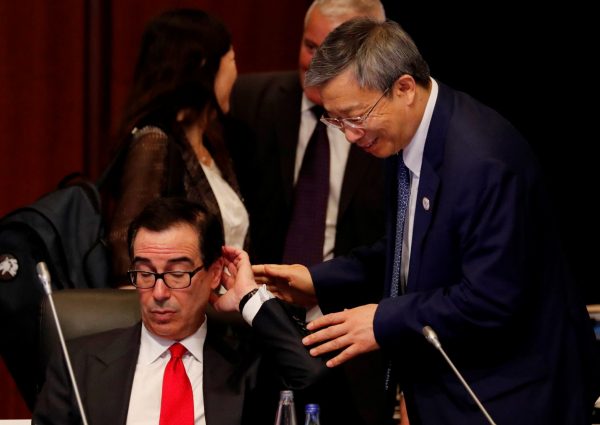This action comes three months after the US Treasury’s semi-annual report on Macroeconomic and Foreign Exchange Policies of Major Trading Partners of the United States added Malaysia, Singapore and Vietnam to a monitoring list of nine countries, including China, Japan, and South Korea, that meet some of the criteria used to identify currency manipulators. It also comes weeks after a proposal by the US Commerce Department to extend countervailing duties to cover imports subsidised by a deliberately undervalued exchange rate.
The US government is clearly concerned about the exchange value of the dollar and its role in perpetuating a large US trade deficit — a key policy concern for US President Donald Trump. But these actions have little practical significance by themselves. The currency manipulator designation carries no meaningful sanctions that are not already in place against China. None of the countries on the monitoring list are likely to be designated manipulators in the near future. And countervailing duties, which would normally require a designation of currency manipulation, would apply only to Chinese imports, which are already subject to punitive tariffs.
US Treasury had been following a flawed set of criteria for currency manipulation that had at least some grounding in theory and data. But with the designation of China, it has abandoned even the pretence of a strategy that treats partner countries fairly and objectively. These actions take the world further from an effective framework for dealing with the real threat of currency manipulation.
C Fred Bergsten and I define currency manipulation as excessive official purchases of foreign currency (more than 2 per cent of GDP) to hold down the value of domestic currency and support a large trade (current account) surplus (more than 3 per cent of GDP). We also require net official foreign-currency assets in excess of three months of imports and 100 per cent of short-term external debt.
Currency manipulation peaked during the ‘decade of manipulation’ from 2003 to 2013 with purchases in excess of US$500 billion per year. We show that the trade effects of currency manipulation reduced US employment by more than 1 million jobs for several years after the Great Recession of 2008–09.
Manipulation has declined substantially since 2013, but three countries — Singapore, Norway and Macao — continued to make excessive currency purchases in 2018 totalling US$106 billion in support of large trade surpluses.
As the issuer of the world’s premier reserve currency, the United States bears the brunt of the trade deficits that are caused by currency manipulation, though all countries are affected. US policymakers have long sought to identify and deter episodes of currency manipulation, but their efforts are distorted by an unjustified focus on bilateral trade balances. This has become even more pronounced under the Trump administration.
Bilateral balances are not a useful indicator of which countries’ policies are contributing to the overall US trade deficit. For example, Singapore has a bilateral trade deficit with the United States, but its large and persistent official purchases of US dollars keep the dollar overvalued, contributing to the US trade deficit.
The US Treasury’s primary criteria for currency manipulation are that a country must have a current account surplus in excess of 2 per cent of GDP, net purchases of foreign exchange reserves in excess of 2 per cent of GDP, and a bilateral trade surplus with the United States of more than US$20 billion per year.
Most of the countries on the monitoring list are not purchasing significant amounts of foreign currencies and will not violate the test as long as they continue to abstain.
But US Treasury retains discretion to apply an older standard for currency manipulation established by the Omnibus Trade and Competitiveness Act of 1988 based on intent to gain an ‘unfair competitive advantage in international trade’ with no numerical guidelines. It is under this authority that US Treasury designated China as a manipulator. US Treasury argued that the depreciation of the renminbi on 5 August was a deliberate policy action given China’s history of managing its exchange rate and its substantial holdings of foreign exchange reserves.
The purpose appears to be mainly to lengthen the charge sheet against China in the ongoing trade war. But US Treasury’s case is clearly weakened by the fact that China’s current account is close to balance and it has not bought significant amounts of foreign exchange in recent years.
To an unfortunate extent, US currency policy appears to be guided more by political than economic considerations. The main target appears to be China, driven by China’s large bilateral trade surplus with the United States. The principal currency manipulators in recent years — Singapore, Switzerland, Norway, Taiwan and Thailand — have evaded Treasury’s designation. Indeed, the bilateral surplus criterion of US$20 billion per year appears to have been set to avoid having to name Taiwan as a manipulator in 2016, when it had a bilateral trade surplus of US$15 billion.
The main US success in the battle against currency manipulation has been the joint pledge of G20 countries to refrain from targeting their exchange rates for competitive purposes. By and large, G20 countries have honoured their pledge over the past four years. Nevertheless, some smaller countries continue to manipulate, and all countries may be tempted to use currency policy to achieve export-led growth during the next global downturn — especially given perceived limitations on the scope for monetary and fiscal stimulus.
The world needs an enforceable set of economically sound rules to prevent beggar-thy-neighbour exchange rate policies. The International Monetary Fund is the appropriate forum in which to debate such rules, but it lacks useful sanctions to enforce them. By attacking the wrong target amid an ill-designed trade war, the United States is sacrificing its moral standing to guide the world to a better outcome on this important issue.
Joseph E Gagnon is a Senior Fellow at the Peterson Institute for International Economics, Washington DC.

